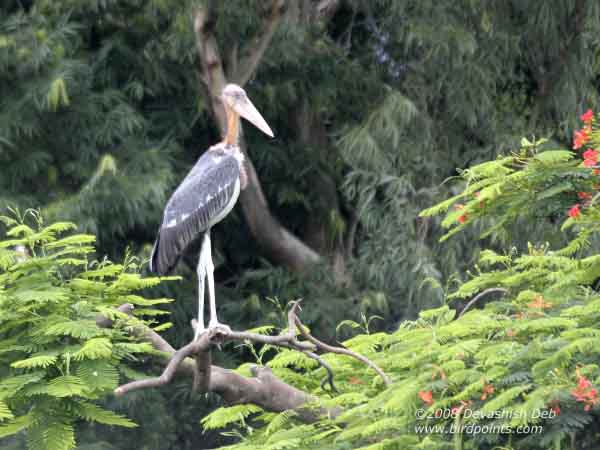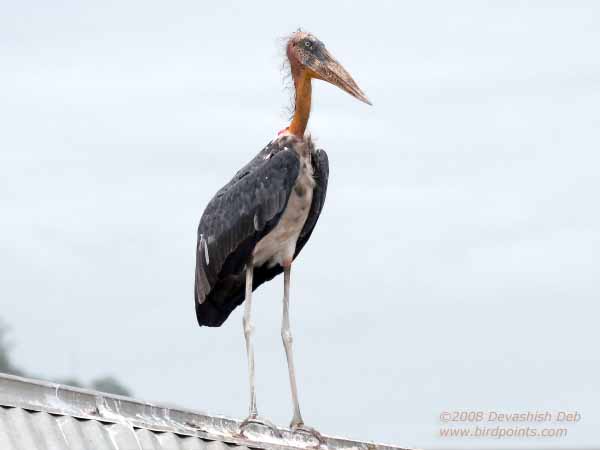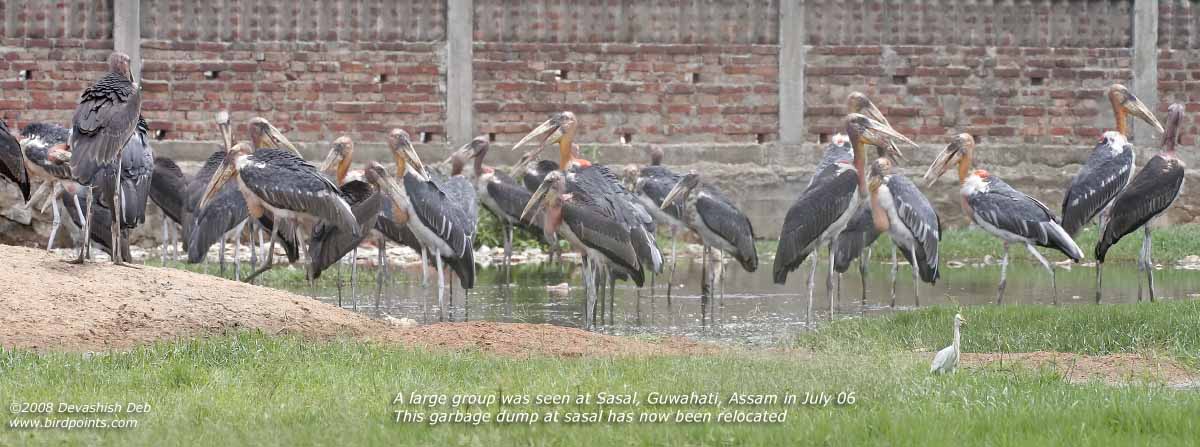IUCN Red
List of Threatened Species: Endangered --
Further Details
Distribution:
Current population estimate
is of only about 1000 adults and young with now known disjunct breeding
records from Assam and Combodia (Hilloljyoti Singha and Asad R. Rahmani
2006).
Legendary
historical record by Oates; he found an enormous colony of
these birds breeding in Pegu in a forest west of Shwaygheen (In Myanmar
- Ed). He said:
Along with the Pelicans, breeding in the same trees, were innumerable
Adjutants. One can hardly realize the number of these birds that visit
Pegu in October, unless, as I have, he has seen the vast armies which
settle on the plains on their first arrival. I have stood on a bund
where I could see about two miles round me, and the whole area was literally
covered with them. Some fifty birds stand huddled together; then there
is a bare space of about 100 feet, and then another group of birds.
Their numbers are incredible. They all arrive suddenly in the Pegu plain
on the same day, and after resting for about two days, they betake themselves
to the forest, where I had the pleasure of visiting them. Certainly
almost all the Indian Adjutants must come to Pegu to breed.
On the same day that we took the Pelican's eggs, we also paid attention
to the Adjutants, but whereas in the case of the Pelicans by climbing
one tree you procure almost as many eggs as you care to have, with the
Adjutants it is different. Frequently there is only a solitary nest
in a tree, rarely two or three, and in this case the tree selected is
a stupendous one, with immense branches reaching 50 feet from the trunk
and mostly horizontal. Fortunately the nests are so frequent that there
is no difficulty, in the course of a morning, in finding accessible
ones in plenty.
November 11th was a trifle too early. Many nests were still being built;
others had no eggs in them, and only a few had the full complement of
three eggs.
The nest is made entirely of coarse sticks, and it is of such a size
that the sitting bird cannot be seen from below, except when she stretches
her head out. It is wedged into a fork as near the exterior of the tree
as possible, whether at the top or side.
The eggs, three in number, are originally pure white and tolerably,
in some specimens very, smooth to the touch. As incubation proceeds
the shell gets much stained and becomes a dark earth-brown. The interior
lining is very dark green. They are very regular ovals, much the same
shape at both ends. Size from 2.82 to 3.1 by 2.08 to 2.25.
These Adjutants utter only one sound, and it resembles the lowing of
a cow when separated from her calf. It was the only sound heard in these
gloomy forests.
Oates,
Eugene W. 1878. Notes on Nidification of some Burmese Birds, II. Stray Feathers VII: 40-52.
It seems that there
are no current resident or breeding colonies in Myanmar (Luthin 1987,
Hancock et al. 1992), however surveys are required throughout for a
possible remnant breeding population (Khin Ma Ma Thwin in litt. 1997).-Ed.
Historical
record by Jerdon:
 The
Adjutant is found throughout the greater part of India, is rare in the
South, but extremely common in part of Northern India, and more especially
in Bengal and North-eastern India. I never saw it in the Carnatic nor
in Malabar; it is occasionally met with in Mysore, and is not rare in
Hyderabad, thence becoming more common and abundant northwards. It spreads
through Burmah to the Malayan peninsula. It is only a temporary resident
in India coming in towards the close of the hot weather in April or
May, and remaining till October. A very few barren or unpaired birds
remain occasionally in parts of the country.
The
Adjutant is found throughout the greater part of India, is rare in the
South, but extremely common in part of Northern India, and more especially
in Bengal and North-eastern India. I never saw it in the Carnatic nor
in Malabar; it is occasionally met with in Mysore, and is not rare in
Hyderabad, thence becoming more common and abundant northwards. It spreads
through Burmah to the Malayan peninsula. It is only a temporary resident
in India coming in towards the close of the hot weather in April or
May, and remaining till October. A very few barren or unpaired birds
remain occasionally in parts of the country.








